Yes, Apples usual to-little-to-live-to-much-to-die spec in case of graphics, which has been consequently continued even in the "Highest End"(and cost!)-machines up to the Pro 7,1. 🙄...in lower spec PCIe G5's
Got a tip for us?
Let us know
Become a MacRumors Supporter for $50/year with no ads, ability to filter front page stories, and private forums.
Question: How powerful of a graphics card will work in a beige Power Macintosh G3?
- Thread starter LeoI07
- WikiPost WikiPost
- Start date
- Sort by reaction score
You are using an out of date browser. It may not display this or other websites correctly.
You should upgrade or use an alternative browser.
You should upgrade or use an alternative browser.
- Status
- The first post of this thread is a WikiPost and can be edited by anyone with the appropiate permissions. Your edits will be public.
6600 #22 ROMs modified for Old World Macs. Untested.Yes, there are a few.
Aside from the Apple OEM one for the 6600LE PCIe, which was used as basic configuration in the late 2005 G5s, i have two for AGP GT cards. One, 128k of size, from the Strangedogs Forum and a "reduced" one, i patched myself.
Attachments
Thanks!6600 #22 ROMs modified for Old World Macs. Untested.
...but that's the point, where even my testing-capabilities come to an end, as i do not have any kind of adaptor to test my 6600 AGP card in the only Old World machine i happen to own. 😉
You can test that the ROM doesn't change anything for whatever New World machine you have....but that's the point, where even my testing-capabilities come to an end, as i do not have any kind of adaptor to test my 6600 AGP card in the only Old World machine i happen to own. 😉
Yes, i can at least give the 6600GT 64k thing a shot in my quicksilver. So, if this works, the others should too, right?You can test that the ROM doesn't change anything for whatever New World machine you have.
To add, what might be the end of the scale to the benchmarks-section, here come some more results.
I'm quite sure, this can be seen as the ultimate in graphics performance available for PPC. At least with Mac OS. There have been experiments with even RTX-series/Turing cards in a G5 Quad involving Linux. But that's another story.
So this is the 7800 GTX, 512MB version in a Quad:
OpenMark

Results for different solutions here have been completely identical. So only this one.
OpenGL Extensions Viewer

3.0 and 3.11 delivered somehow same results. These are 3.0.
And, for better comparability to the other results listed, a more common resolution, closer to the most commonly used 1280 x 1024, this is 1344 x 1008:

I'm quite sure, this can be seen as the ultimate in graphics performance available for PPC. At least with Mac OS. There have been experiments with even RTX-series/Turing cards in a G5 Quad involving Linux. But that's another story.
So this is the 7800 GTX, 512MB version in a Quad:
OpenMark
Results for different solutions here have been completely identical. So only this one.
OpenGL Extensions Viewer
3.0 and 3.11 delivered somehow same results. These are 3.0.
And, for better comparability to the other results listed, a more common resolution, closer to the most commonly used 1280 x 1024, this is 1344 x 1008:
Last edited:
Not necessarily. The patches are applied manually so it's possible for mistakes to be made. Also, all three of your 6600 ROMs use different FCode versions. 2166, 2361, and 2149 though I suspect the 2149 is actually 2361 since it doesn't match the 2149 version of the GeForce 7800. Did some of these have their rom-revision modified? I can't tell if the 2166 or 2361 are newer or better than 2149 or 2152.2 - I don't think it matters since Open Firmware is a small part of the boot process - it doesn't need to do much more than display the Apple logo.Yes, i can at least give the 6600GT 64k thing a shot in my quicksilver. So, if this works, the others should too, right?
Code:
bbdiff "Forth/6600GT_64k.4th" "Forth/6600GT_128k.4th"
# 64k : BIOS:5.43.02.75.00 FCode:2166 \\ not valid checksum
# 128k: BIOS:5.43.02.75.00 FCode:2361 \\ not valid checksum
# 64k : device id nvstrap: 4D
# 128k: device id nvstrap: 50
# 64k : 47
# 128k: 43
# 64k : 4D -> 42 GeForce 6600GT
# 128k: 50 -> 45 GeForce 6600
# NVStraps differ
# neither of these have second part of NVStraps
# some code changes
# NVDA,BMP changes in a couple bytes
bbdiff "Forth/6600GT_128k.4th" "Forth/Apple_GeForce_6600_256Mb_PCIe.4th"
# 128K: Device ID in PCI Data Structure: 00F1
# PCIe: Device ID in PCI Data Structure: 0141
# 128K: BIOS:5.43.02.75.00 FCode:2361 \\ not valid checksum
# PCIe: BIOS:5.43.02.75.00 FCode:2149 \\ valid checksum
# NVStraps differ but both have 0050 after Vendor ID
# neither of these have second part of NVStraps
# some value differences
# some NVDA,BMP differences
# otherwise, the code is identical (more similar than 2166)
bbdiff "Forth/Apple_GeForce_6600_256Mb_PCIe.4th" "../7800/Forth/Gainward Bliss 256.4th"
# these are both Fcode 2149 but the code doesn't match
bbdiff "Forth/Apple_GeForce_6600_256Mb_PCIe.4th" "../7800/Forth/7800GT.4th"
# 2149 vs 2152.2 ; code doesn't matchI think 2560x1600 would be the best resolution to test since the frame rates of lower resolutions are ridiculously large. High frame rates means more emphasis is put on CPU and PCI bandwidth which Old World Macs lack.To add, what might be the end of the scale to the benchmarks-section, here come some more results.
I'm quite sure, this can be seen as the ultimate in graphics performance available for PPC. At least with Mac OS. There have been experiments with even RTX-series/Turing cards in a G5 Quad involving Linux. But that's another story.
So this is the 7800 GTX, 512MB version in a Quad:
OpenMark
View attachment 2111498
Results for different solutions here have been completely identical. So only this one.
OpenGL Extensions Viewer
View attachment 2111500
3.0 and 3.11 delivered somehow same results. These are 3.0.
And, for better comparability to the other results listed, a more common resolution, closer to the most commonly used 1280 x 1024, this is 1344 x 1008:
View attachment 2111501
Sure! I did the 1344 x 1008 run only to be a bit more "comparable", as most of the other results are 1280 x 1024.I think 2560x1600 would be the best resolution to test since the frame rates of lower resolutions are ridiculously large.
I tried the OpenMark bench mark on my Quad G5, Leopard, Mac 7800GT using 1920x1200@60Hz, 2560x1600@60Hz, 3840x2160@30Hz (the last two using Gefen Dual Link DVI to DisplayPort adapter. I don't remember if I've ever tried 4K on the G5 before - I suppose one might want to enable HiDPI mode in that case)
For OpenMark, the number of pixels affects frame rates up to a certain number of triangles, then the FPS is the same for all three. I graphed that in Excel. The final benchmark score is similar for all three.
The OpenGL Extensions Viewer tests were mostly affected by screen size. Versions 3.0 and 3.1.1 produce similar results.

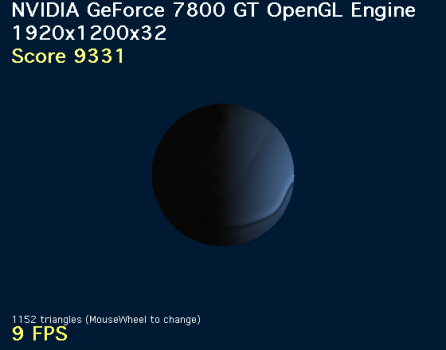
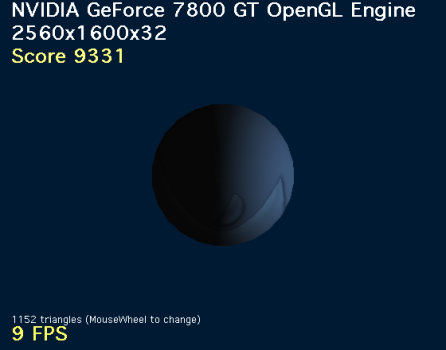
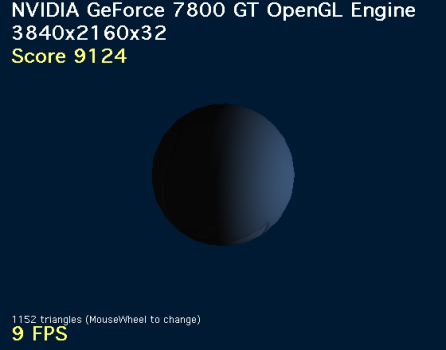
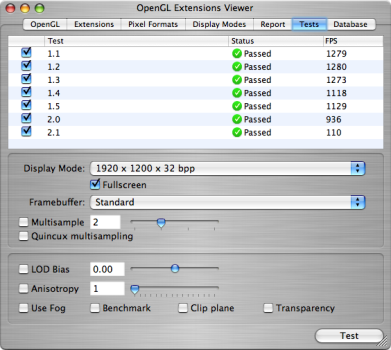

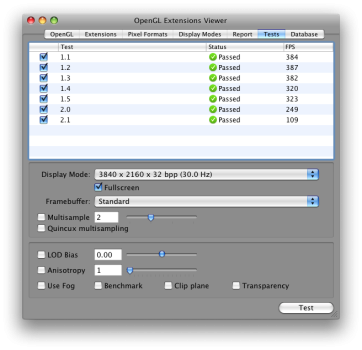
For OpenMark, the number of pixels affects frame rates up to a certain number of triangles, then the FPS is the same for all three. I graphed that in Excel. The final benchmark score is similar for all three.
The OpenGL Extensions Viewer tests were mostly affected by screen size. Versions 3.0 and 3.1.1 produce similar results.







Attachments
Did you use the Run Benchmark menu item in OpenMark? It will generate a txt file and a tga file. Post the txt file so we can see where it differs from my 7800GT.So this is the 7800 GTX, 512MB version in a Quad:
Did not go just as high this time.Did you use the Run Benchmark menu item in OpenMark? It will generate a txt file and a tga file. Post the txt file so we can see where it differs from my 7800GT.
Here is some new result...
..along with the corresponding textfile.
Attachments
Both of our cards are CPU/PCIe bandwidth limited for low number of triangles (they start with the same FPS). The GTX breaks away after that.Did not go just as high this time.
Here is some new result...
View attachment 2112992
..along with the corresponding textfile.
My GT reaches the bandwidth limit at a lower resolution (1920x1200). The GTX is able to reach the bandwidth limit closer to 2560x1600. I suppose we need to test super low resolutions (640x480?) to verify the bandwidth limit.
The GTX is able to do more triangles before it reaches 9 FPS - the cutoff of the benchmark.

Nice thread, is there any way to further edit e.g. the 5200/6200 ROM to use the full 66 MHz on e.g. the B&W (32-bit slot, so 267MB/s as opposed to 133MB/s)? I don't know if these cards already do take full advantage of the 66MHz slot.
Or to fully use e.g. a PCIe card at 267MB/s (full 1x) using a PCIe to PCI 64-bit/33MHz PCIe bridge? What about using card on a PCIe to PCI-X bridge on the G5 (PCI-X) at 4X, do ROMs need modifying for for this?
Thanks!
Or to fully use e.g. a PCIe card at 267MB/s (full 1x) using a PCIe to PCI 64-bit/33MHz PCIe bridge? What about using card on a PCIe to PCI-X bridge on the G5 (PCI-X) at 4X, do ROMs need modifying for for this?
Thanks!
Which Old World Macs have PCI 1.0?Will this work on OldWorld machines that have PCI 1.0 (and not 1.1) for cards that are PCI 1.1+? I remember editing a GF 2 ROM alongside the lines of what was first posted for a PM 5400 but could never get it to work
Which cards are PCI 1.1+?
I think PCI devices are usually backward compatible.
There's a successful test of the 6200 in a PowerTower Pro which I think has Open Firmware 1.0.5, just like the Power Macs 7500, ..., 9600. #685
I think PCI speeds are outside the control of the driver - a card should use the max speed common between itself and the slot.Nice thread, is there any way to further edit e.g. the 5200/6200 ROM to use the full 66 MHz on e.g. the B&W (32-bit slot, so 267MB/s as opposed to 133MB/s)? I don't know if these cards already do take full advantage of the 66MHz slot.
Or to fully use e.g. a PCIe card at 267MB/s (full 1x) using a PCIe to PCI 64-bit/33MHz PCIe bridge? What about using card on a PCIe to PCI-X bridge on the G5 (PCI-X) at 4X, do ROMs need modifying for for this?
66MHz is a flag in the PCI config space registers. The firmware of the B&W G3 should show that flag as a property of the device in Open Firmware.
Does anyone sell 64 bit bridge adapters? The first post notes that there exists such bridge chips and that StarTech did sell an adapter that used one of those bridge chips (supports PCI-X 64-bit 133MHz to PCIe x4) but their version might not support 66MHz, just 33 and 133MHz. Basically, we want an adapter that can do 33/66/100/133 MHz, 32/64bit, PCI/PCI-X, PCIe x4. Bonus points for 3.3V/5V.
PCIe x1 is 250 MB/s (2.5 GT/s 8b/10b encoding).
Use the ThroughPut app to test bandwidth.
https://forums.macrumors.com/threads/anyone-still-have-a-copy-of-the-app-throughput.2364714/
Sorry for it having been a while til i found the time to test this.You can test that the ROM doesn't change anything for whatever New World machine you have.
Now i tried the 6600GT 64k ROM from Test 2 of your archive. I get a garbeled screen and the Quicksilver doesn't fully boot to the desktop with it. But this may well be because the 6600GT 64k ROM i posted before was for some other card, but not the Galaxy. There are many different, like a Winfast, a XFX, a Sparkle and so on. I don't know, which particular one i posted. But they differ in RAM-timings etc. so are not interchangable. Attached you find the ROM, i am using with this particular Galaxy Dual Bios card and which proven works.
Also, yes, i edited the Chipset Name and ROM Revision in these ROMs randomly to mark them. I did not know the revision number referring to some "real" Fcode-version. So sorry for that confusion. I think, the rom attached basically origins to the 2150.
Attachments
Even with 640x480 looking "a bit" strange on a 30" Cinema HD, i did run this test.I suppose we need to test super low resolutions (640x480?) to verify the bandwidth limit.
The overall score is exactly the same. But also included is the textfile to inspect, if it shows any differences.
Attachments
I guess I was wrong about the bandwidth limit. It seems you can always get more fps by going lower resolution, up to a certain number of triangles.Even with 640x480 looking "a bit" strange on a 30" Cinema HD, i did run this test.
The overall score is exactly the same. But also included is the textfile to inspect, if it shows any differences.

Thanx for ULing the graph in a size, readable even for older guys! 😉I guess I was wrong about the bandwidth limit. It seems you can always get more fps by going lower resolution, up to a certain number of triangles.
View attachment 2118728
Nice to see in direct comparison, what sheer clockrate can do.
By the way, ok topic of some other thread, but do you think getting those "unknown" standard AHCI-devices to boot in PPCs is completely impossible?
It's a thumbnail. You can click it to load the full size version.Thanx for ULing the graph in a size, readable even for older guys! 😉
OpenFirmware doesn't have AHCI drivers. I checked the class codes of all the Quad G5 fcode images.By the way, ok topic of some other thread, but do you think getting those "unknown" standard AHCI-devices to boot in PPCs is completely impossible?
There's only four fcode images that are loaded by PCI class code.
There's ten PCI devices that have fcode images loaded by their PCI vendor/device IDs.
Code:
0000 0000 FFFF FFFF 0006 0700 https://pci-ids.ucw.cz/read/PD/06/07 # CardBus bridge
0000 0000 FFFF FFFF 0006 0400 https://pci-ids.ucw.cz/read/PD/06/04 # PCI bridge
0000 0000 FFFF FFFF 000C 0310 https://pci-ids.ucw.cz/read/PD/0C/03/10 # USB OHCI
0000 0000 FFFF FFFF 000C 0010 https://pci-ids.ucw.cz/read/PD/0C/00/10 # FireWire OHCI
0000 1BD0 0043 106B FFFF FFFF https://pci-ids.ucw.cz/read/PC/106B/0043 # K2 ATA/100
147478: 087360: FFFF E430 0050 106B FFFF FFFF https://pci-ids.ucw.cz/read/PC/106B/0050 # Shasta IDE
FFFF DE20 0051 106B FFFF FFFF https://pci-ids.ucw.cz/read/PC/106B/0051 # Shasta (Sun GEM) Sungem ethernet controler
FFFF DE20 0000 0000 0240 1166 https://pci-ids.ucw.cz/read/PC/1166/0240 # K2 SATA
0000 0420 4301 14E4 FFFF FFFF https://pci-ids.ucw.cz/read/PC/14E4/4301 # BCM4301 802.11b Wireless LAN Controller
150944: 08A018: FFFF FBE0 4320 14E4 FFFF FFFF FFFF FBE0 https://pci-ids.ucw.cz/read/PC/14E4/4320 # BCM4306 802.11b/g Wireless LAN Controller
0000 5FF8 1648 14E4 FFFF FFFF 0000 0000 https://pci-ids.ucw.cz/read/PC/14E4/1648 # NetXtreme BCM5704 Gigabit Ethernet
157665: 090000: FFFF A028 16A7 14E4 FFFF FFFF FFFF A028 https://pci-ids.ucw.cz/read/PC/14E4/16A7 # NetXtreme BCM5703X Gigabit Ethernet
157667: 09000C: FFFF FFF0 1668 14E4 FFFF FFFF FFFF A018 https://pci-ids.ucw.cz/read/PC/14E4/1668 # NetXtreme BCM5714 Gigabit Ethernet
FFFF FFF0 166A 14E4 FFFF FFFF FFFF A008 https://pci-ids.ucw.cz/read/PC/14E4/166A # NetXtreme BCM5780 Gigabit EthernetMac OS X 10.4 Tiger has AHCI drivers but only for Intel.
Mac OS X 10.5 Leopard has AHCI drivers. It's not on Apple Open Source. I wonder if the drivers can be used in Tiger with some minor Info.plist changes?
So shouldn't a
rd= boot-arg allow booting from a AHCI device using a helper disk - an Open Firmware bootable device containing the kernel extensions required for boot?If you want to boot without helper disk, then you need a Open Firmware AHCI driver. You would need to load it from disk or block device or. PCI card exansion ROM since we don't know exactly how to put it in the Mac's ROM (but we know how to get the fcode images from Mac ROM - the reverse might involve things we don't know about that we don't use for getting the fcode images).
I'm trying to boot my Power Mac 8600 into Tiger using my version of XPostFacto that I'm working on to set a helper disk. The helper disk is required because when I used Disk Utility.app in Leopard on my Quad G5 to copy the Quad G5's Tiger partition, it did not preserve the HFS Wrapper of the destination partition that all the other partitions on my destination disk had when I partitioned it in Leopard with "Install Mac OS 9 Drivers" selected. The Quad G5's partitions don't have HFS Wrappers because the Quad G5 is a New World Mac and doesn't require it for booting. Disk Utility.app on the Quad G5 is able to put Mac OS 9 Drivers and HFS Wrappers on external disks (I had the destination disk connected using FireWire - but it is connected in the 8600 as a ATA disk connected to a controller that treats disks as SCSI for Mac OS 9 compatibility - it's a 120GB SATA SSD with a ATA adapter).
Yes! Allready downloaded the chart. This wasn't ironic. I was happy in fact.It's a thumbnail. You can click it to load the full size version.
If this is the method XPF uses, it didn't work for me. It just booted to the helper. Or can it be, that the helper is just shown by "About this Mac", while it "really" booted to the AHCI-drive?So shouldn't ard=boot-arg allow booting from a AHCI device using a helper disk - an Open Firmware bootable device containing the kernel extensions required for boot?
That's what i was afraid to be the answer. But sure it has to.If you want to boot without helper disk, then you need a Open Firmware AHCI driver.
Do you use some special version of XPF?I'm trying to boot my Power Mac 8600 into Tiger using my version of XPostFacto that I'm working on to set a helper disk.
TypeOr can it be, that the helper is just shown by "About this Mac", while it "really" booted to the AHCI-drive?
df in Terminal and note the device mounted at /. This is the root device OS X is running from. Use Disk Utility to find out which drive that corresponds to.
Last edited:
The helper disk created by XPostFacto just includes all the kernel extensions from /System/Library/Extensions.If this is the method XPF uses, it didn't work for me. It just booted to the helper. Or can it be, that the helper is just shown by "About this Mac", while it "really" booted to the AHCI-drive?
Every other file accessed by Mac OS X will be from the root drive - the mount point for
/TheTypedfin Terminal and note the device mounted at/. This is the root device OS X is running from. Use Disk Utility to find out which drive that corresponds to.
mount command also works.diskutil info disk1s1 will give info for a single disk.diskutil info all will give info for all disks.I have a fork on github but I haven't made any commits yet. I am updating it with some code I worked on from several years ago, plus some fixes from my usage this week.Do you use some special version of XPF?
I was able to boot into Tiger 10.4.11 from the helper disk on my 8600 but it was kind of slow. It has a Sonnet 1 GHz G4. Hopefully some cache enabling software will make it better? What should I use? I've just installed Sonnet Cache Control 1.4. I'll test it later.
I want to find a method to add the HFS Wrapper without erasing the Tiger partition because I don't want to use a Helper partition if I don't need to. My idea would be to create a HFS Wrapper partition on a different disk - make it the exact size of what would be required to wrap my Tiger partition, shrink the partition that precedes the Tiger partition, decrease the start position of the Tiger partition, then copy just the wrapper to the new start of the Tiger partition.
What does the directory structure look like when using an XPF helper disk? I used it a long time ago and I can't seem to remember what it looks like.The helper disk created by XPostFacto just includes all the kernel extensions from /System/Library/Extensions.
Register on MacRumors! This sidebar will go away, and you'll see fewer ads.

